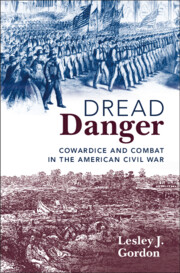Refine search
Actions for selected content:
15401 results in Military history
Maps and Figures
-
- Book:
- Dread Danger
- Published online:
- 07 November 2024
- Print publication:
- 21 November 2024, pp vi-vi
-
- Chapter
- Export citation
Contents
-
- Book:
- Dread Danger
- Published online:
- 07 November 2024
- Print publication:
- 21 November 2024, pp v-v
-
- Chapter
- Export citation
6 - “A Skeleton of Itself”: Mississippi and Texas
- from Part II - The 2nd Texas Infantry Regiment
-
- Book:
- Dread Danger
- Published online:
- 07 November 2024
- Print publication:
- 21 November 2024, pp 227-281
-
- Chapter
- Export citation
Abbreviations
-
- Book:
- Dread Danger
- Published online:
- 07 November 2024
- Print publication:
- 21 November 2024, pp x-x
-
- Chapter
- Export citation
Bibliography
-
- Book:
- Dread Danger
- Published online:
- 07 November 2024
- Print publication:
- 21 November 2024, pp 285-307
-
- Chapter
- Export citation
Part II - The 2nd Texas Infantry Regiment
-
- Book:
- Dread Danger
- Published online:
- 07 November 2024
- Print publication:
- 21 November 2024, pp 137-281
-
- Chapter
- Export citation
Introduction - “Almost Enough to Make Cowards of the Bravest Men”
-
- Book:
- Dread Danger
- Published online:
- 07 November 2024
- Print publication:
- 21 November 2024, pp 1-12
-
- Chapter
- Export citation
Copyright page
-
- Book:
- Dread Danger
- Published online:
- 07 November 2024
- Print publication:
- 21 November 2024, pp iv-iv
-
- Chapter
- Export citation
2 - “Effervescent Courage”: Virginia
- from Part I - The 11th New York Volunteer Infantry Regiment
-
- Book:
- Dread Danger
- Published online:
- 07 November 2024
- Print publication:
- 21 November 2024, pp 52-90
-
- Chapter
- Export citation
Index
-
- Book:
- Dread Danger
- Published online:
- 07 November 2024
- Print publication:
- 21 November 2024, pp 308-318
-
- Chapter
- Export citation
4 - “The Display of Soldiery”: Texas
- from Part II - The 2nd Texas Infantry Regiment
-
- Book:
- Dread Danger
- Published online:
- 07 November 2024
- Print publication:
- 21 November 2024, pp 139-181
-
- Chapter
- Export citation
1 - “Soldiers, and Yet Not Soldiers”: New York and Washington, DC
- from Part I - The 11th New York Volunteer Infantry Regiment
-
- Book:
- Dread Danger
- Published online:
- 07 November 2024
- Print publication:
- 21 November 2024, pp 15-51
-
- Chapter
- Export citation
3 - “Soul Sick”: Virginia and New York
- from Part I - The 11th New York Volunteer Infantry Regiment
-
- Book:
- Dread Danger
- Published online:
- 07 November 2024
- Print publication:
- 21 November 2024, pp 91-136
-
- Chapter
- Export citation

Dread Danger
- Cowardice and Combat in the American Civil War
-
- Published online:
- 07 November 2024
- Print publication:
- 21 November 2024
1 - Race, Military Spectacle and the West India Regiments
-
- Book:
- Soldiers of Uncertain Rank
- Published online:
- 17 October 2024
- Print publication:
- 31 October 2024, pp 1-24
-
- Chapter
- Export citation
2 - The Spectre of a Black Soldiery
-
- Book:
- Soldiers of Uncertain Rank
- Published online:
- 17 October 2024
- Print publication:
- 31 October 2024, pp 25-52
-
- Chapter
- Export citation
Dedication
-
- Book:
- Soldiers of Uncertain Rank
- Published online:
- 17 October 2024
- Print publication:
- 31 October 2024, pp v-vi
-
- Chapter
- Export citation
Index
-
- Book:
- Soldiers of Uncertain Rank
- Published online:
- 17 October 2024
- Print publication:
- 31 October 2024, pp 242-248
-
- Chapter
- Export citation
Contents
-
- Book:
- Soldiers of Uncertain Rank
- Published online:
- 17 October 2024
- Print publication:
- 31 October 2024, pp vii-vii
-
- Chapter
- Export citation
Figures
-
- Book:
- Soldiers of Uncertain Rank
- Published online:
- 17 October 2024
- Print publication:
- 31 October 2024, pp viii-x
-
- Chapter
- Export citation
